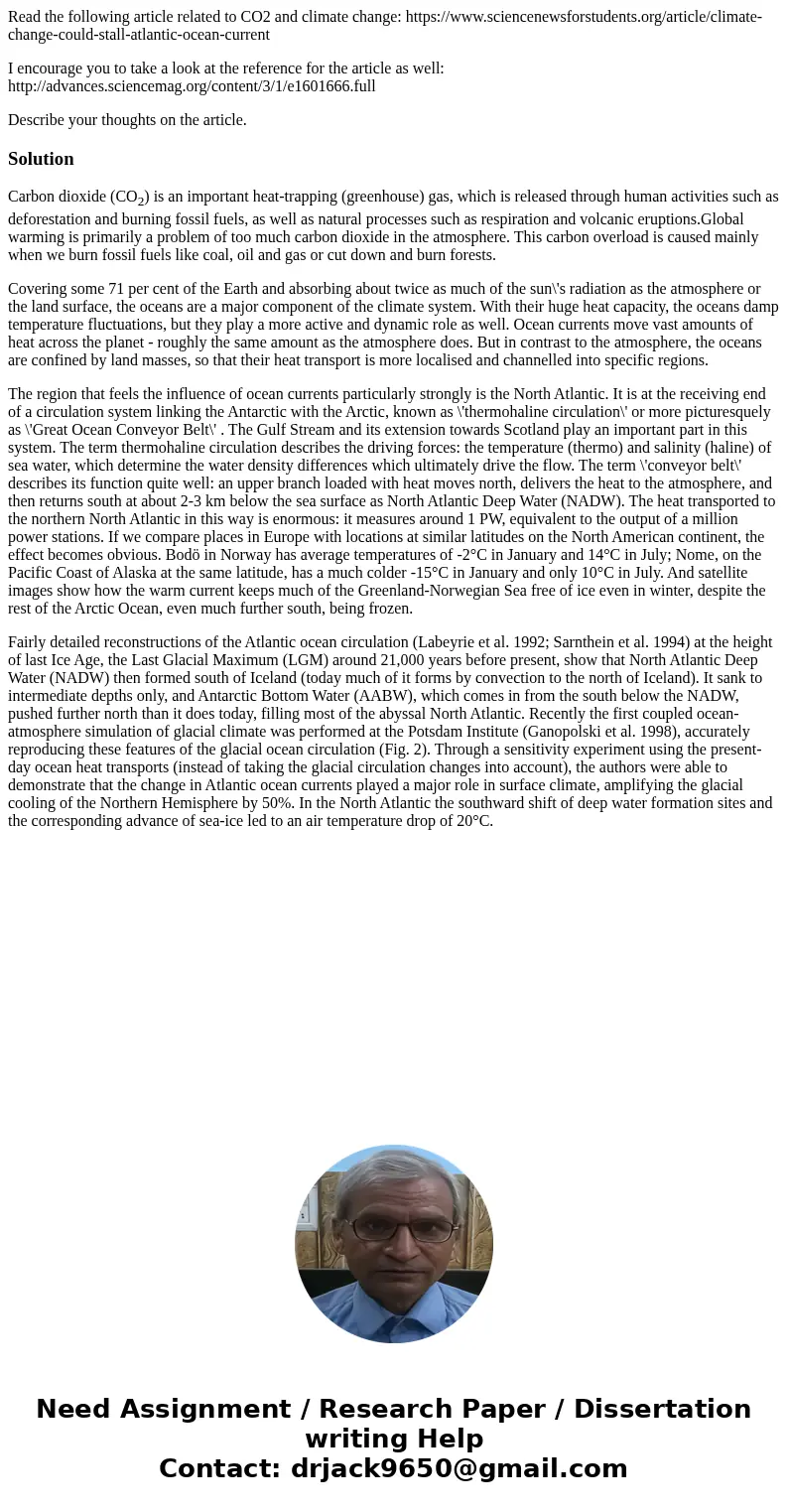Read the following article related to CO2 and climate change
Read the following article related to CO2 and climate change: https://www.sciencenewsforstudents.org/article/climate-change-could-stall-atlantic-ocean-current
I encourage you to take a look at the reference for the article as well: http://advances.sciencemag.org/content/3/1/e1601666.full
Describe your thoughts on the article.
Solution
Carbon dioxide (CO2) is an important heat-trapping (greenhouse) gas, which is released through human activities such as deforestation and burning fossil fuels, as well as natural processes such as respiration and volcanic eruptions.Global warming is primarily a problem of too much carbon dioxide in the atmosphere. This carbon overload is caused mainly when we burn fossil fuels like coal, oil and gas or cut down and burn forests.
Covering some 71 per cent of the Earth and absorbing about twice as much of the sun\'s radiation as the atmosphere or the land surface, the oceans are a major component of the climate system. With their huge heat capacity, the oceans damp temperature fluctuations, but they play a more active and dynamic role as well. Ocean currents move vast amounts of heat across the planet - roughly the same amount as the atmosphere does. But in contrast to the atmosphere, the oceans are confined by land masses, so that their heat transport is more localised and channelled into specific regions.
The region that feels the influence of ocean currents particularly strongly is the North Atlantic. It is at the receiving end of a circulation system linking the Antarctic with the Arctic, known as \'thermohaline circulation\' or more picturesquely as \'Great Ocean Conveyor Belt\' . The Gulf Stream and its extension towards Scotland play an important part in this system. The term thermohaline circulation describes the driving forces: the temperature (thermo) and salinity (haline) of sea water, which determine the water density differences which ultimately drive the flow. The term \'conveyor belt\' describes its function quite well: an upper branch loaded with heat moves north, delivers the heat to the atmosphere, and then returns south at about 2-3 km below the sea surface as North Atlantic Deep Water (NADW). The heat transported to the northern North Atlantic in this way is enormous: it measures around 1 PW, equivalent to the output of a million power stations. If we compare places in Europe with locations at similar latitudes on the North American continent, the effect becomes obvious. Bodö in Norway has average temperatures of -2°C in January and 14°C in July; Nome, on the Pacific Coast of Alaska at the same latitude, has a much colder -15°C in January and only 10°C in July. And satellite images show how the warm current keeps much of the Greenland-Norwegian Sea free of ice even in winter, despite the rest of the Arctic Ocean, even much further south, being frozen.
Fairly detailed reconstructions of the Atlantic ocean circulation (Labeyrie et al. 1992; Sarnthein et al. 1994) at the height of last Ice Age, the Last Glacial Maximum (LGM) around 21,000 years before present, show that North Atlantic Deep Water (NADW) then formed south of Iceland (today much of it forms by convection to the north of Iceland). It sank to intermediate depths only, and Antarctic Bottom Water (AABW), which comes in from the south below the NADW, pushed further north than it does today, filling most of the abyssal North Atlantic. Recently the first coupled ocean-atmosphere simulation of glacial climate was performed at the Potsdam Institute (Ganopolski et al. 1998), accurately reproducing these features of the glacial ocean circulation (Fig. 2). Through a sensitivity experiment using the present-day ocean heat transports (instead of taking the glacial circulation changes into account), the authors were able to demonstrate that the change in Atlantic ocean currents played a major role in surface climate, amplifying the glacial cooling of the Northern Hemisphere by 50%. In the North Atlantic the southward shift of deep water formation sites and the corresponding advance of sea-ice led to an air temperature drop of 20°C.

 Homework Sourse
Homework Sourse